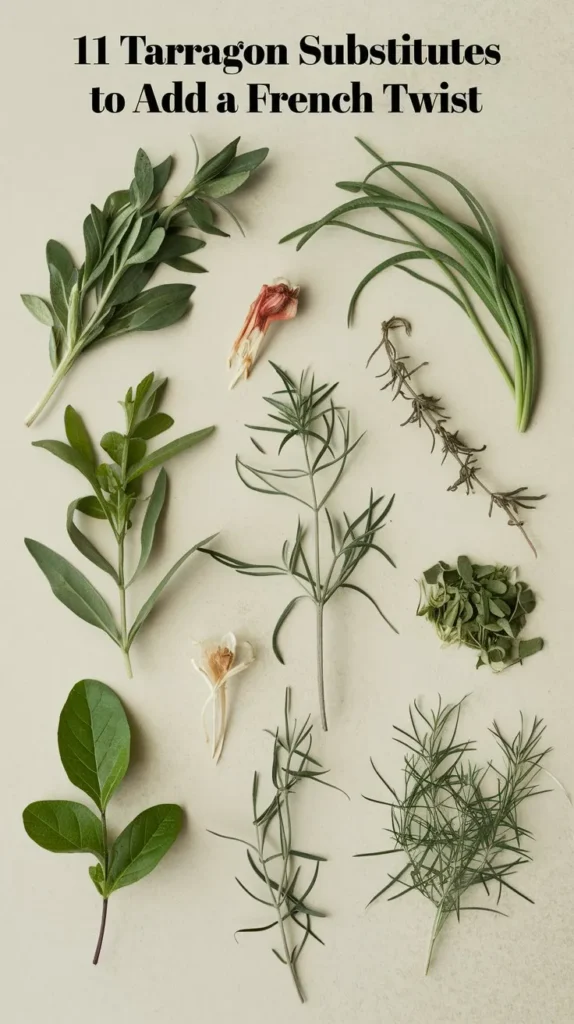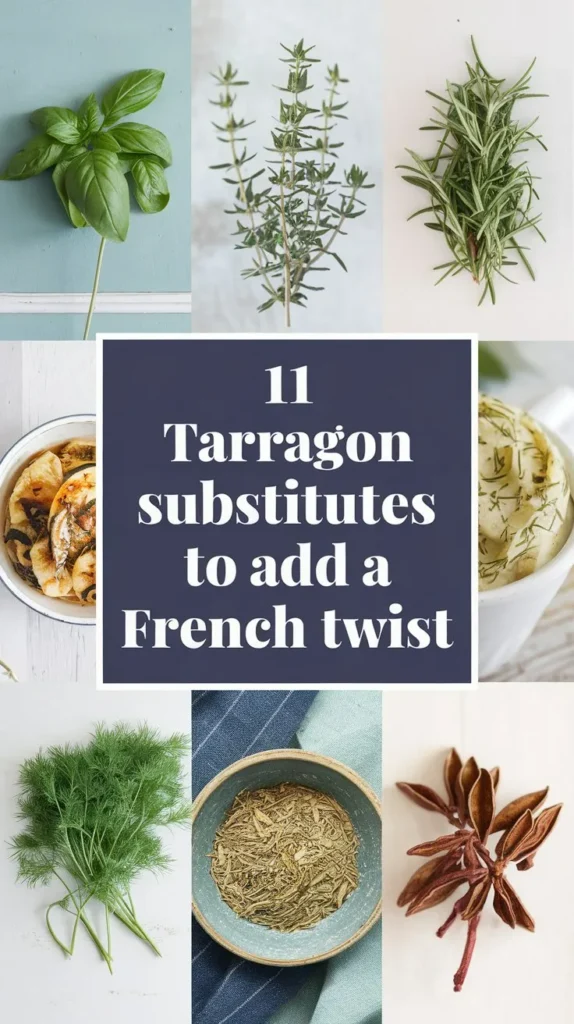11 Tarragon Substitutes to Add a French Twist to Your Cooking
You’re looking to add a touch of French flair to your cooking, but tarragon’s not your go-to herb. Don’t worry, you’re not alone! Tarragon can be tricky to find, and sometimes you need a substitute that’ll still bring that je ne sais quoi to your dishes.
Luckily, you have options – 11 of them, to be exact. From sweet and aromatic to fresh and herbaceous, these substitutes will give you the flexibility to experiment with new flavors and find the perfect fit for your recipe. But which one will you choose?
At a Glance
- Basil offers a sweet and aromatic substitute for tarragon, pairing well with chicken, fish, and vegetables in French-inspired dishes.
- Chervil’s delicate anise-like flavor makes it an excellent substitute for tarragon, elevating dishes without overpowering them.
- Fresh herbs like parsley and dill provide bright and herbaceous flavor profiles, perfect for adding a French twist to soups, salads, and sandwiches.
- Marjoram and fennel offer piney and bitter flavor profiles, making them great substitutes for tarragon in grilled meats or vegetable dishes.
- Anise-flavored substitutes like anise seed and star anise add depth and warmth to dishes, while thyme and bay leaves provide savory and minty options.
Basil: A Sweet and Aromatic Substitute
When seeking a tarragon substitute, you may be surprised to find that basil, a herb commonly associated with Italian and Thai cuisine, can fill the gap.
Sweet Basil, with its bright green leaves and pungent aroma, offers an aromatic alternative that will elevate your dishes. While basil’s flavor profile is slightly sweeter than tarragon’s anise-like taste, it pairs well with chicken, fish, and vegetables, making it an excellent addition to a variety of recipes.
When using basil as a tarragon substitute, start with a smaller amount, as its flavor can be overpowering.
Chop the leaves finely to release their oils and add them towards the end of cooking to preserve their delicate flavor. You’ll find that basil’s sweetness complements the richness of creamy sauces and the brightness of citrus, making it an ideal choice for dishes like chicken piccata or seafood risotto.
With its versatility and adaptability, basil proves to be a reliable and flavorful substitute for tarragon, allowing you to experiment with new recipes and flavor combinations.
Parsley: Fresh Flavor and Crunch
Parsley’s fresh, green flavor and satisfying crunch make it an excellent tarragon substitute, particularly in dishes where you want a bright, herbaceous note without the anise undertones.
You’ll appreciate parsley’s versatility in adding a pop of freshness to various recipes. Use it as a fresh garnish option to elevate soups, salads, and sandwiches. Its delicate flavor won’t overpower other ingredients, making it an ideal choice for pairing with lighter proteins like chicken, fish, or tofu.
When exploring parsley pairing ideas, consider combining it with lemon, garlic, and olive oil for a Mediterranean-inspired flavor profile.
You can also add it to herb butters or sauces for a subtle, herbaceous note. Parsley’s mild flavor makes it an excellent addition to dishes where you want to add depth without overwhelming other flavors.
Whether you’re looking to add a bright, fresh flavor or a satisfying crunch, parsley is an excellent tarragon substitute that’s sure to impress.
Chervil: Delicate and Anise-Like
Discovering the subtle nuances of chervil, you’ll find that its delicate, anise-like flavor profile makes it an intriguing tarragon substitute.
This French herb embodies the essence of French herbaceousness, with a subtle sweetness and a hint of anise undertones.
When used in cooking, chervil adds a refined, sophisticated flavor that elevates dishes to new heights.
- Delicate flavor: Chervil’s subtle flavor won’t overpower your dishes, making it an excellent choice for delicate sauces, soups, and salads.
- Anise undertones: Chervil’s anise undertones add a unique twist to your cooking, perfect for French-inspired dishes like bouillabaisse or chicken Provençal.
- Versatility: Chervil pairs well with a variety of ingredients, from fish and poultry to vegetables and legumes, making it a versatile addition to your spice rack.
Dill: Bright and Refreshing Flavor
Several sprigs of fresh dill can transport you to a sunny summer day, its bright and invigorating flavor evoking memories of pickles, salads, and grilled fish.
You’ll find that dill’s distinct flavor profile is a perfect complement to a variety of dishes, from classic dill pickle recipes to fresh dill sauces that elevate grilled meats and vegetables.
When using dill as a tarragon substitute, you’ll notice its flavor is more pronounced, with a slightly sweet and citrusy undertone.
To get the most out of dill’s flavor, use it in combination with creamy ingredients like sour cream or mayonnaise to balance out its brightness.
You can also add it to soups, stews, or braises for an added layer of depth.
With its versatility and rejuvenating flavor, dill is an excellent addition to any dish, whether you’re looking to add a pop of flavor or evoke the feeling of a sunny summer day.
Marjoram: Piney and Slightly Bitter
While you may not immediately think of marjoram as a suitable tarragon substitute, its piney, slightly bitter flavor profile makes it an intriguing alternative.
This herb, often used in Mediterranean and Middle Eastern cuisine, can add a unique twist to your dishes. Marjoram’s flavor is more delicate than oregano, with a sweeter, more floral quality that complements chicken, fish, and vegetables.
- Herbal sauces: Combine marjoram with lemon juice, garlic, and olive oil to create a bright, herbaceous sauce perfect for grilled meats or vegetables.
- Roasted vegetables: Toss sliced or chopped vegetables with olive oil, salt, and marjoram for a flavorful and aromatic side dish.
- Chicken or fish marinades: Mix marjoram with lemon juice, olive oil, and garlic for a marinade that adds depth and piney undertones to your protein of choice.
When using marjoram as a tarragon substitute, keep in mind that its bitter flavors are more pronounced, so start with a small amount and adjust to taste.
Fennel: Licorice-Flavored and Versatile
You may have already encountered fennel in its various forms – from the crunchy, anise-flavored bulb to the delicate, lacy fronds – but have you considered its potential as a tarragon substitute?
Fennel’s unique flavor profile, which combines sweet and bitter notes with a hint of licorice, makes it an intriguing alternative.
There are two primary types of fennel: sweet fennel, commonly used in Italian cooking, and bitter fennel, often used in Indian and Middle Eastern cuisine.
Fennel has a rich history, dating back to ancient Greece and Rome, where it was used for medicinal and culinary purposes.
Its versatility extends beyond flavor, as the bulb can be sautéed, roasted, or pickled, while the fronds add a fresh, anise-like flavor to salads and sauces.
With its subtle yet distinctive flavor, fennel can add a sophisticated twist to dishes like chicken, fish, and vegetables, making it an excellent tarragon substitute in many recipes.
Give fennel a try and explore its possibilities in your kitchen!
Anise Seed: Pungent and Aromatic
Savoring the pungent aroma of anise seed, you’ll discover a flavor profile that’s both familiar and distinct, making it an excellent tarragon substitute in many recipes.
This ancient spice has been used for centuries, with a rich history dating back to ancient Egypt, Greece, and Rome, where it was used to flavor food, drinks, and even perfumes.
- Unique flavor profile: Anise seed’s warm, sweet, and slightly bitter flavor adds depth to dishes without overpowering them.
- Digestive benefits: Anise seed has natural carminative properties, which can help alleviate digestive issues like bloating and gas.
- Versatility: Anise seed can be used whole, ground, or as an oil, making it a flexible addition to a variety of recipes, from baked goods to savory dishes.
Anise seed benefits extend beyond its flavor profile, as it’s also rich in antioxidants and has anti-inflammatory properties.
When substituting anise seed for tarragon, start with a small amount and adjust to taste, as its pungency can quickly overpower a dish.
With its distinct flavor and numerous benefits, anise seed is an excellent addition to your spice rack.
Star Anise: Warm and Spicy Flavor
Unfolding the petals of star anise, you’re met with a warm, spicy flavor that’s reminiscent of licorice, but with a more delicate, sweet undertone.
This ancient spice, native to southern China, has a rich history dating back to the 16th century when it was traded along the Silk Road. Star anise benefits extend beyond its culinary uses, as it’s also prized for its medicinal properties, including reducing inflammation and improving digestion.
When using star anise as a tarragon substitute, you’ll find that it adds a unique depth to dishes like chicken, fish, and soups.
Its warm, slightly sweet flavor pairs particularly well with citrus and ginger, making it an excellent addition to marinades and sauces. To release the full flavor of star anise, toast the whole spice in a dry pan or grind it into a fine powder.
With its distinctive flavor and aroma, star anise is sure to become a staple in your spice rack, adding a touch of exotic elegance to your cooking.
Thyme: Savory and Slightly Minty
As I reach for the tiny, delicate leaves of thyme, I’m drawn into a world of savory nuances and subtle minty undertones.
In French cuisine, thyme is a staple herb, often paired with rosemary and sage to create a classic bouquet garni.
When substituting for tarragon, thyme adds a slightly more robust flavor profile, making it an excellent choice for heartier dishes.
- Herb-crusted chicken: Mix thyme with olive oil, garlic, and lemon zest for a flavorful rub that elevates roasted chicken to new heights.
- Vegetable soups: Add thyme to your favorite vegetable soups for a depth of flavor that complements the natural sweetness of the vegetables.
- Herb pairing options: Pair thyme with lemon balm for a bright, citrusy flavor or with parsley for a fresh, green note.
When using thyme as a substitute for tarragon, keep in mind that it has a stronger flavor, so start with a smaller amount and adjust to taste.
With its versatility and nuanced flavor, thyme is an excellent addition to any kitchen, especially when exploring the world of French cuisine.
Bay Leaves: Mellow and Slightly Sweet
While thyme’s robust flavor profile makes it an excellent choice for heartier dishes, bay leaves offer a more subtle, mellow flavor that’s perfect for lighter fare.
You’ll appreciate the delicate, slightly sweet taste bay leaves bring to soups, stews, and braises. One of the significant bay leaf benefits is its ability to enhance the flavors of other ingredients without overpowering them.
There are several bay leaf varieties to choose from, including Turkish, Italian, and Californian.
Turkish bay leaves are considered the most aromatic, while Italian bay leaves have a milder flavor. Californian bay leaves, on the other hand, have a stronger, more bitter taste.
When using bay leaves, remember to remove them before serving, as they can be quite bitter if ingested whole.
Fresh or dried, bay leaves add a unique flavor dimension to your dishes, making them an excellent substitute for tarragon in many recipes.
Caraway Seeds: Nutty and Slightly Bitter
Three types of caraway seeds are commonly used in cooking: black, brown, and white.
You might be surprised to learn that caraway seeds have been used for centuries, with a rich history dating back to ancient Europe and Asia. They weren’t only used as a spice but also for their medicinal properties.
- Digestive aid: Caraway seeds have natural carminative properties, which help to reduce bloating and gas.
- Anti-inflammatory: Caraway seeds contain antioxidants that help to reduce inflammation and improve overall health.
- Flavor enhancer: Caraway seeds add a unique, slightly bitter and nutty flavor to dishes, making them a great addition to soups, stews, and baked goods.
When substituting tarragon with caraway seeds, start with a small amount and adjust to taste, as the flavor can be quite strong.
Remember that caraway seeds pair well with ingredients like apple, potato, and sausage, making them a great addition to hearty winter dishes.
FAQs
Can I Grow My Own Tarragon at Home?
You can grow your own tarragon at home, choosing from French, Russian, or Mexican varieties, but make sure to provide the right growing conditions, including well-draining soil, partial shade, and moderate watering to thrive.
How Do I Store Fresh Tarragon to Keep It Fresh?
You’ll want to store fresh tarragon in a sealed container, wrapped in damp paper towels, to maintain its delicate flavor and aroma; try herb preservation methods like freezing or drying to extend its shelf life, and follow freshness maintenance tips like storing it in the refrigerator at 32°F to 50°F.
Is Tarragon Safe for People With Allergies?
When you’re considering tarragon, you’ll want to know it’s generally safe, but you should be aware of potential allergy triggers, especially if you’re sensitive to herbal reactions, as some people may experience mild skin irritation or digestive issues.
Can I Use Dried Tarragon as a Substitute?
You can use dried tarragon, but you’ll need to adjust the spice ratio to compensate for the concentrated flavor; start with a small amount, as dried tarragon packs a punch, and taste as you go to achieve the perfect balance of Tarragon flavor.
What Is the Difference Between French and Russian Tarragon?
You’ll notice French tarragon’s anise-like flavor profiles and sweet, licorice aromatic differences are more delicate, whereas Russian tarragon’s flavor is bitter and earthier, with a less pronounced anise taste, allowing you to choose the perfect variety for your recipe.









DK Jacks is a passionate food enthusiast, recipe developer, and culinary explorer. With a love for both traditional and innovative flavors, DK brings a fresh perspective to the kitchen. When not experimenting with new ingredients, you’ll find DK capturing food moments through the lens or sharing cooking tips with fellow foodies.🍽️📸✨







